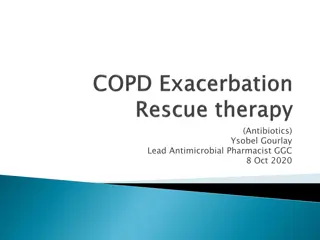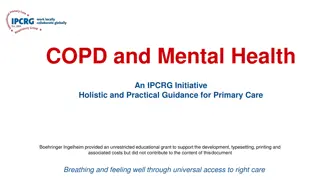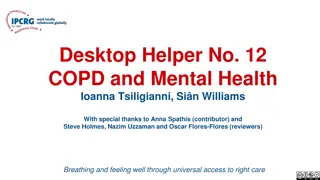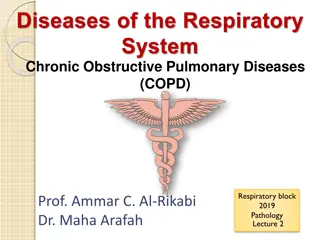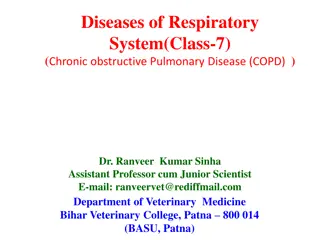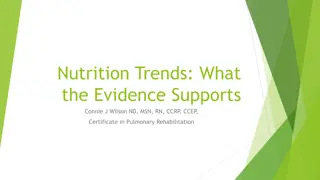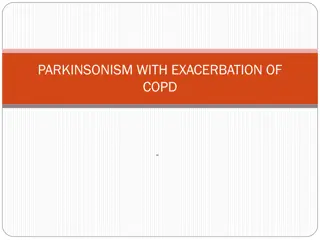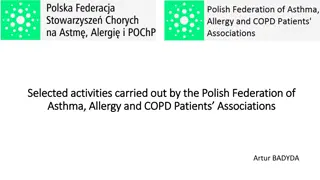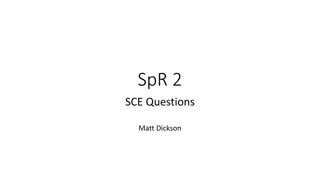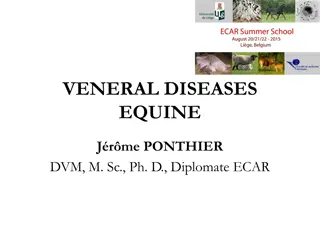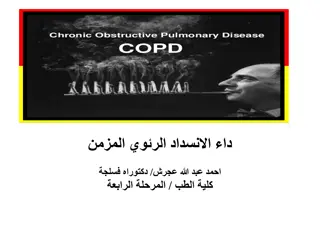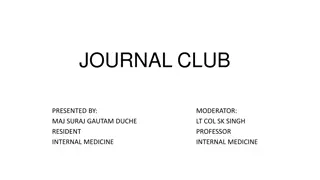COPD: Diagnosis, Treatment, and Management Overview
Chronic Obstructive Pulmonary Disease (COPD) is a lung condition that can be managed with proper care. This article discusses a case study, including patient history, physical examination, investigations, and treatment provided. Learn about the symptoms, risk factors, and complications associated with COPD.
Download Presentation

Please find below an Image/Link to download the presentation.
The content on the website is provided AS IS for your information and personal use only. It may not be sold, licensed, or shared on other websites without obtaining consent from the author.If you encounter any issues during the download, it is possible that the publisher has removed the file from their server.
You are allowed to download the files provided on this website for personal or commercial use, subject to the condition that they are used lawfully. All files are the property of their respective owners.
The content on the website is provided AS IS for your information and personal use only. It may not be sold, licensed, or shared on other websites without obtaining consent from the author.
E N D
Presentation Transcript
Objectives: History Introduction Epidemiology Aetiology Risk factors Pathology types clinical features investigation Management Complication 3/19/2025 2
Case presentation: HISTORY: patient of 61yrs age,known smoker, was alright 3 months back when he developed cough which was gradual in onset, progressive, containing sputum, aggravated on night, associated with shortness of breath. PAST HISTORY: No history of DM,HTN,IHD,Asthma d no other chronic illness. There is no history of same complaints in past. PERSONAL $ SOCIOECONOMIC HISTORY: He is tobacco addict and belongs to lower socioeconomic status. 3/19/2025 3
GENERAL PHYSICAL EXAMINATION: A middle aged man sitting on bed with mask on face, having iv branula on right hand, fully oriented in time place and person, having vitals pulse: 88/mint BP: 120/70 RR: 21/min Temp: A/F SPO2 : 90% with o2 inhalation 3/19/2025 4
pursed lips prolonged expiration increased sputum clubbing use of accessory muscles orthropneic 3/19/2025 5
SYSTEMIC EXAMINATION: CNS: GCS 15/15 CVS: S1+S2+ No murmur R.S: NVB+ bilateral crepts and ronchi. GIT: abd soft non tender, no visceromegaly 3/19/2025 6
INVESTIGATION: CBC Hb: 18gm/dl RBC: 6.69million/ul wbc: 11000 polmorphs: 70% basophils: 0% eosinophils: 3% lymphos: 27% platelets:188000 ESR: 40mm 3/19/2025 7
Chest Xray: 3/19/2025 8
Treatment given: Oxygen inhalation IV Moxifloxacin 400mg nebulization with ipratropium and betamethasone tab bamifylline 600mg anti tussive containg terbutaline and bromohexine given 3/19/2025 9
INTRODUCTION: COPD is defined as a preventable and treatable lung disease with some significant extra pulmonary effects that may contribute to the severity in individual patients. The pulmonary component is characterized by airflow limitation that is not fully reversible. The airflow limitation is usually progressive and associated with an abnormal inflammatory response of the lung to noxious particles or gases 3/19/2025 10
EPIDEMIOLOGY Prevalence is directly related to the prevalence of tobacco smoking and, in low- and middle-income countries, the use of biomass fuels. Current estimates suggest that 80 million people world- wide suffer from moderate to severe disease. In 2005, COPD contributed to more than 3 million deaths (5% of deaths globally), but by 2020 it is forecast to represent the third most important cause of death world-wide. 3/19/2025 11
AETIOLOGY Cigarette smoking represents the most significant risk factor for COPD and relates to both the amount and the duration of smoking. It is unusual to develop COPD with less than 10 pack years (1 pack year = 20 cigarettes/day/year) and not all smokers develop the condition, suggesting that individual susceptibility factors are important. 3/19/2025 12
Risk factors: Tobacco smoke Biomass solid fuel fires: wood, animal dung, crop residues and coal lead to high levels of indoor air pollution Occupation: coal miners and those who work with cadmium Outdoor and indoor air pollution Low birth weight: may reduce maximally attained lung function in young adult life Lung growth: childhood infections or maternal smoking may affect growth of lung during childhood, resulting in a lower maximally attained lung function in adult life 3/19/2025 13
Infections: recurrent infection may accelerate decline in FEV1 ; persistence of adenovirus in lung tissue may alter local inflammatory response predisposing to lung damage; HIV infection is associated with emphysema Low socioeconomic status Nutrition: role as independent risk factor unclear Cannabis smoking Host factors Genetic factors: 1 -antiproteinase deficiency; other COPD susceptibility genes are likely to be identified Airway hyper-reactivity 3/19/2025 14
PATHOLOGY 3/19/2025 15
Types of COPD EMPHYSEMA CHRONIC BRONCHITIS o Blue bloaters o 40-55 yrs of age o Dyspnea mild, late o Early, copious sputum o Cor pulmonale common Pink buffers 50-75 yrs of age Dyspnea early and severe Late and scanty sputum Cor pulmonale rare, terminal Airway resistance normal or slightly increased Elastic recoil low On CXR hyper inflated lungs and small heart o Resistance increased o Elastic recoil normal o On CXR enlarged vessels , large heart 3/19/2025 16
EMPHYSEMA BRONCHITIS 3/19/2025 17
SIGN AND SYMPTOMS OF COPD 3/19/2025 18
INVESTIGATION CBC to rule out anemia and polycythemia CXR SPIROMETRY HRCT chest 3/19/2025 19
Spirometric classification of COPD 3/19/2025 20
MANAGEMENT 1-SMOKING CESSATION : Reducing the number of cigarettes smoked each day has little impact on the course and prognosis of COPD, but complete cessation is accompanied by an improvement in lung function and deceleration in the rate of FEV1 decline. Introduction of non-smoking cooking devices or the use of alternative fuels should be encouraged. 3/19/2025 21
2-Bronchodilators: Bronchodilator therapy is central to the management of breathlessness. The inhaled route is preferred. Short-acting bronchodilators, such as the 2 - agonists salbutamol and terbutaline, or the anticholinergic, ipratropium bromide, may be used for patients with mild disease. Longer acting bronchodilators, such as the 2 - agonists salmeterol and formoterol, or the anticholinergic tiotropium bromide, are more appropriate for patients with moderate to severe disease. 3/19/2025 22
Oral bronchodilator therapy may be contemplated in patients who cannot use inhaled devices efficiently. Theophylline preparations improve breathlessness and quality of life, but their use has been limited by side effects, unpredictable metabolism and drug interactions. Bambuterol, a pro-drug of terbutaline, is used on occasion. Orally active highly selective phosphodiesterase inhibitors are currently under development. 3/19/2025 23
3-CORTICOSTEROIDS Inhaled corticosteroids (ICS) reduce the frequency and severity of exacerbations; they are currently recommended in patients with severe disease (FEV1 < 50%) who report two or more exacerbations requiring antibiotics or oral steroids per year. Regular use is associated with a small improvement in FEV1 , but they do not alter the natural history of the FEV1 decline. It is more usual to prescribe a fixed combination of an ICS with a LABA 3/19/2025 24
4-PULMONARY REHABILITATION: Exercise should be encouraged at all stages and patients should be reassured that breathlessness, whilst distressing, is not dangerous. Multidisciplinary programmes that incorporate physical training, disease education and nutritional counseling reduce symptoms, improve health status and enhance confidence. Most programmes include 2 3 sessions per week, last between 6 and 12 weeks, and are accompanied by demonstrable and sustained improvements in exercise tolerance and health status. 3/19/2025 25
5-OXYGEN THERAPY: Long-term domiciliary oxygen therapy (LTOT) has been shown to be of significant benefit in specific patients . It is most conveniently provided by an oxygen concentrator and patients should be instructed to use oxygen for a minimum of 15 hours/ day; greater benefits are seen in patients who receive > 20 hours/day. The aim of therapy is to increase the PaO2 to at least 8 kPa (60 mmHg) or SaO2 to at least 90%. 3/19/2025 26
3/19/2025 27
6-SURGERY: Young patients in whom large bullae compress surrounding normal lung tissue, who otherwise have minimal airflow limitation and a lack of generalized emphysema, may be considered for bullectomy. Patients with predominantly upper lobe emphysema, with preserved gas transference and no evidence of pulmonary hypertension, may benefit from lung volume reduction surgery (LVRS), in which peripheral emphysematous lung tissue is resected with the aim of reducing hyperinflation and decreasing the work of breathing may lead to improvements in FEV1 , lung volumes, exercise tolerance and quality of life 3/19/2025 28
Other measures: Patients with COPD should be offered an annual influenza vaccination and, as appropriate, pneumococcal vaccination. Obesity, poor nutrition, depression and social isolation should be identified and, if possible, improved. Mucolytic therapy such as acetylcysteine, or antioxidant agents are occasionally used but with limited evidence. 3/19/2025 29
PROGNOSIS: The prognosis is inversely related to age and directly related to the post-bronchodilator FEV1 . Additional poor prognostic indicators include weight loss and pulmonary hypertension 3/19/2025 30
3/19/2025 31
3/19/2025 32



